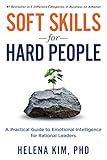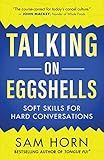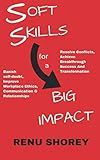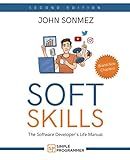Best Soft Skills Development Books to Buy in January 2026

Try Softer: A Fresh Approach to Move Us out of Anxiety, Stress, and Survival Mode--and into a Life of Connection and Joy



Soft Skills for Hard People: A Practical Guide to Emotional Intelligence for Rational Leaders



Talking on Eggshells: Soft Skills for Hard Conversations



SOFT SKILLS for a BIG IMPACT: Banish Self-Doubt, Improve Workplace Ethics, Communication and Relationships, Resolve Conflicts, Achieve Breakthrough Success and Transformation



The Next Conversation: Argue Less, Talk More



Soft Skills: The Software Developer's Life Manual


When it comes to showcasing your soft skills on a resume, it is important to effectively highlight and articulate them to potential employers. Here are a few tips on how to do it:
- Understand the relevance: Soft skills are personal attributes and qualities that help you work well with others, such as communication, leadership, teamwork, adaptability, problem-solving, and time management. Familiarize yourself with these skills and determine which ones are the most relevant for the job you are applying for.
- Analyze the job description: Carefully read the job description and identify the soft skills that the employer is looking for. Tailor your resume to emphasize these specific skills to show your suitability for the role.
- Provide examples: Simply mentioning your soft skills is not enough. Support your claims by providing concrete examples of situations where you have demonstrated these skills in previous roles or experiences. For instance, if you possess strong leadership skills, describe a project or initiative you led and the positive outcomes achieved.
- Use action verbs: Rather than using generic adjectives to describe your soft skills, incorporate action verbs that highlight your abilities. For example, instead of saying you have good communication skills, use phrases like "effectively communicated," "collaborated," or "facilitated."
- Show results: Whenever possible, quantify the impact of your soft skills in terms of results or achievements. For instance, if you improved team collaboration, mention that it resulted in a 20% increase in productivity or reduced project completion time by 15%.
- Incorporate them in the work experience section: One practical way to showcase your soft skills is by integrating them into your work experience section. Use bullet points to describe situations where you have applied these skills and the positive outcomes they generated.
- Utilize the summary or objective statement: You can also showcase your soft skills in the summary or objective statement at the beginning of your resume. Choose a few key soft skills that align with the job requirements and highlight them in a concise and impactful manner.
- Include relevant certifications or training: If you have completed any certifications or training programs related to your soft skills (e.g., communication workshops, leadership seminars), include them in a dedicated section or under the education section of your resume.
- Seek endorsements or recommendations: If you have endorsements or recommendations from previous employers, colleagues, or clients that speak to your soft skills, consider incorporating them into your resume. These testimonials can add credibility and further support your claims.
Remember, the goal is to showcase your soft skills in a way that demonstrates your ability to contribute positively to the role and the company. By effectively communicating your soft skills on your resume, you increase your chances of standing out to potential employers and securing interviews.
What is the best way to showcase your ability to handle stressful situations on a resume?
- Use specific examples: Instead of just listing "ability to handle stressful situations" as a skill, include specific examples of stressful situations you have successfully navigated. For each example, describe the situation, your approach, the actions you took, and the positive outcomes achieved. This will demonstrate your ability to handle stress effectively.
- Highlight relevant experience: If you have prior work experience in high-pressure environments, such as customer service, project management, or emergency response roles, highlight these experiences on your resume. Mention any accomplishments or recognition gained during these situations, emphasizing your ability to remain calm and make sound decisions under pressure.
- Focus on problem-solving skills: Stressful situations often require strong problem-solving abilities. Highlight your problem-solving skills in your resume, describing situations where you successfully resolved complex problems under pressure. Illustrate your ability to think critically, adapt quickly, and find practical solutions to overcome challenges.
- Include measurable results: When discussing stressful situations, quantify your achievements whenever possible. For example, mention how you met deadlines, reduced customer complaints, increased productivity, or achieved specific project goals. Including measurable results demonstrates not only your ability to handle stress but also your effectiveness in delivering positive outcomes.
- Incorporate positive attributes: Employers value candidates who possess certain qualities that help them handle stress, such as resilience, adaptability, composure, and effective communication. Use your resume to highlight these attributes by including them as key skills or qualities, or by mentioning situations where you demonstrated these characteristics successfully in high-pressure environments.
- Provide relevant certifications or training: If you have obtained any certifications or completed training related to stress management, crisis response, or handling high-pressure situations, include them on your resume. This demonstrates your proactive approach in acquiring the necessary skills to handle stress effectively.
- Obtain references or testimonials: If possible, request references or testimonials from previous employers, coworkers, or supervisors who can vouch for your ability to handle stress. These references could emphasize your performance in difficult situations and provide additional credibility to showcase your stress-management skills.
Remember to tailor your resume to the specific job you are applying for, focusing on experiences or qualities that directly relate to the role's demands and responsibilities.
How to showcase your attention to detail skills when writing a resume?
When writing a resume, it is important to showcase your attention to detail skills as employers highly value this quality. Here are a few ways to highlight your attention to detail:
- Use proper formatting: Ensure that your resume is well-structured, consistent, and error-free. Pay attention to details such as spacing, alignment, font choices, and bullet points to display your meticulousness.
- Proofread diligently: Thoroughly proofread your resume multiple times to catch any spelling, grammar, or punctuation errors. This demonstrates your commitment to accuracy and attention to detail.
- Quantify achievements: Include specific quantitative achievements or results that you have accomplished in previous roles. This displays your ability to focus on specific details and achieve measurable outcomes.
- Include specific examples: Incorporate details and specific examples of how you have successfully utilized your attention to detail skills in the past. This could include complicated projects you managed, meticulous data analysis, or close attention to quality control, among others.
- Use action verbs: When describing your work experience, use action verbs that imply attention to detail, such as "analyzed," "scrutinized," "validated," or "inspected." These verbs indicate that you are detail-oriented and thorough in your work.
- Include relevant certifications or training: If you have attended workshops, training programs, or obtained certifications related to attention to detail or quality management, be sure to mention them in the skills or certifications section of your resume.
- Customize for each application: Tailor your resume to match the specific requirements of the job you are applying for. Carefully review the job posting or description, paying attention to specific details, and align your resume accordingly. This demonstrates your ability to pay attention to specifics and adapt your approach accordingly.
By incorporating these strategies into your resume, you will effectively showcase your attention to detail skills, enabling potential employers to recognize your thoroughness and accuracy.
What are some examples of problem-solving situations that can be highlighted on a resume?
- Implementing a new system or process: Describe how you identified a problem in the existing workflow, developed a solution, and successfully implemented it. Highlight the positive impact achieved, such as increased efficiency, cost savings, or improved customer satisfaction.
- Resolving customer complaints or issues: Share specific instances where you effectively addressed customer concerns or complaints, demonstrating your ability to empathize, analyze the situation, brainstorm solutions, and provide satisfactory resolutions.
- Analyzing data and making informed decisions: Describe a situation where you confronted a complex problem, analyzed relevant data, and used critical thinking skills to come up with an informed decision. Emphasize the positive outcomes resulting from your decision-making process.
- Team conflict resolution: Showcase your ability to mediate conflicts within a team environment. Outline a situation where you successfully resolved interpersonal conflicts, facilitated effective communication, and reached mutually beneficial solutions that improved team dynamics and productivity.
- Cost-saving initiatives: Share instances where you identified cost-saving opportunities within an organization. Explain how you conducted research, analyzed the situation, developed a cost-saving plan, and successfully implemented it, resulting in significant financial savings for the company.
- Streamlining processes: Highlight situations where you identified inefficiencies in a process, developed strategies for improvement, and successfully streamlined the process, resulting in enhanced productivity, reduced errors, or shorter turnaround times.
- Project management: Illustrate your project management skills by mentioning a specific project where you successfully coordinated multiple tasks, managed resources, solved challenges, and delivered the project within budget and on time. Highlight any achievements or positive outcomes resulting from your project management abilities.
- Negotiation and conflict resolution: Describe a situation where your negotiation skills successfully resolved a conflict or resulted in a beneficial outcome for all parties involved. Emphasize your ability to listen, understand various perspectives, find common ground, and reach mutually satisfying agreements.
- Adapting to change: Share a situation where you successfully adapted to a new technology, process, or organizational change. Highlight your problem-solving skills by explaining how you identified challenges, developed strategies to overcome them, and ultimately thrived in the new circumstances.
- Troubleshooting technical issues: If you possess technical skills, share an example where you effectively troubleshooted and resolved a technical issue. Describe the problem, your diagnostic approach, the steps you took to fix it, and the positive impact it had on operational efficiency or customer satisfaction.
Remember to provide measurable results or quantifiable achievements for each problem-solving situation mentioned on your resume.
How to effectively highlight your problem-solving abilities on a resume?
To effectively highlight your problem-solving abilities on a resume, consider the following steps:
- Use specific keywords: Look for keywords related to problem-solving skills in the job description and company values. Incorporate these keywords throughout your resume to demonstrate your proficiency.
- Include a skills section: Create a dedicated section to showcase your problem-solving skills. Use bullet points to highlight specific skills such as critical thinking, analytical reasoning, creativity, and decision-making abilities.
- Share relevant accomplishments: Incorporate specific instances where you successfully solved a problem or overcame a challenge in your previous roles. Use bullet points to describe the problem, the actions you took, and the positive outcome or impact.
- Quantify your achievements: Whenever possible, quantify the impact of your problem-solving skills. For example, mention how your solution improved efficiency, reduced costs, increased productivity, or enhanced customer satisfaction.
- Provide examples from different scenarios: Demonstrate a diverse range of problem-solving abilities by mentioning examples from different aspects of your professional experience, such as team projects, customer interactions, or process improvements.
- Utilize your cover letter: While your resume provides a summary of your problem-solving abilities, your cover letter allows you to delve deeper into specific examples or experiences that showcase your skills. Use this space to share a more comprehensive story that highlights your problem-solving proficiency.
- Highlight relevant qualifications: If you possess any certifications, training, or education that is directly related to problem-solving, make sure to include them on your resume. This demonstrates a commitment to developing and improving your problem-solving abilities.
- Be concise and clear: Avoid generic statements and instead focus on specific examples and outcomes that highlight your problem-solving expertise. Use concise language and action verbs to describe your achievements and abilities.
Remember, standing out as an effective problem solver on your resume is not just about listing skills, but also showing concrete examples of how you have applied those skills successfully in various situations.
